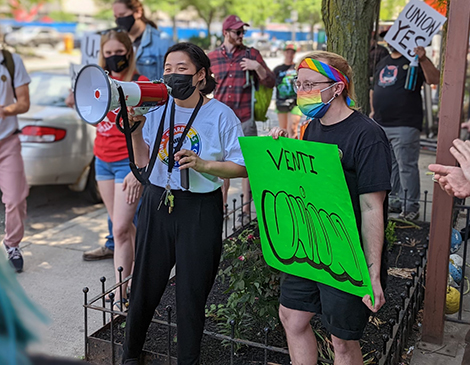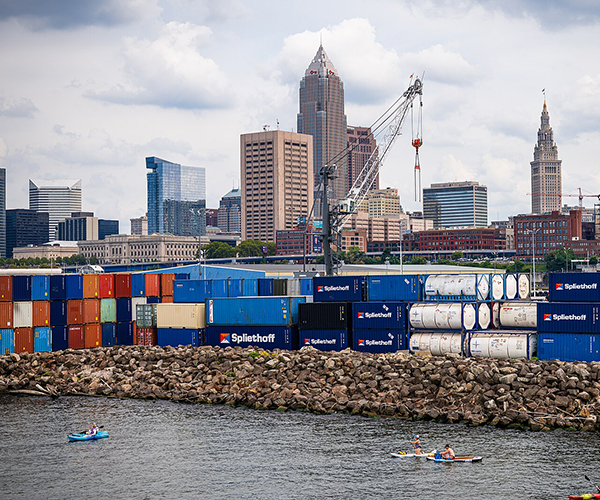Dennis Weber’s phone screen illuminates his dark car. It’s 5 a.m., and he’s in Crocker Park’s parking garage, reviewing a carefully worded email.
Snowflakes float down, outside his sedan. He’s scared, he says — but excited, too. This early morning feels like a milestone after several hard months.
Two coworkers pull up in the quiet, nearly empty garage at the Westlake shopping development. The Starbucks crew reads over the email for a final time; the same email they’d sent back and forth the previous day for edits.
They didn’t get here early to prepare, although, in another world, they might have. Exactly one week ahead of Thanksgiving, this day welcomes the first tastes of an oncoming onslaught of holiday-themed everything. After all, it’s Red Cup Day, Starbucks’ fabricated and infamous holiday that celebrates the chain’s much-anticipated shift to holiday beverages: sugar-filled caramel brulee flavor, white chocolate mochas and, of course, the iconic peppermint latte.
RELATED: Take a sip of Cleveland's coffee scene at these 34 shops and cafes.
This day the corporation gifts customers their own reusable cups, free of charge, while supplies last: an annual collector’s item for Starbs stans. This day brings throngs of customers through the doors, sometimes overwhelming the coffee shop workers.
And this day, Weber nervously looks at his email one last time. He takes a breath, and then he presses “send.”
At 5:30 a.m. on Nov. 16, 2022, when this shop would normally open its doors for one of the busiest work days of the year, the strike — coordinated between more than 100 Starbucks stores in the country — begins.
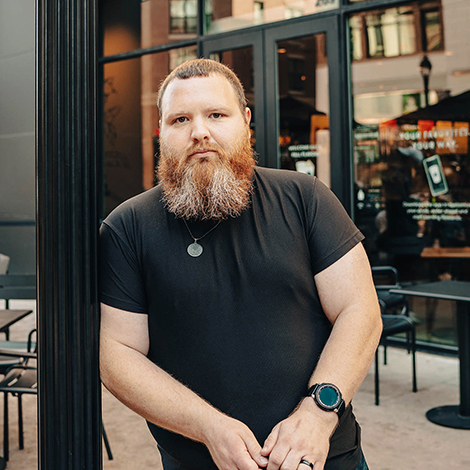
(Photo by Ellen Gobeille)
Weber and his teammates head to the front of their Starbucks location — the one between an ice cream shop and a pizzeria. It’s one of five Starbucks cafes located in the Westlake shopping district, which is smaller than a quarter of a square mile. It’s one shop, of more than 16,000 company-owned and licensed Starbucks in the United States. One, of more than 37,000 around the world.
The crew begins its day of action, armed with hastily made picket signs and a to-the-point chant: “No contract, no coffee.” Weber’s anxiety fades as he watches many of the shop’s regular customers turn away upon seeing the strike. Regional Transit Authority workers even arrive, carrying their Amalgamated Transit Union signs in support. Three people, then six, then 15.
In the midst of this, police are called on the group; it moves to Detroit Road, away from Crocker’s private property.
“It wasn’t great, because we wanted to be in front,” Weber says, “but everybody who came to us and we told about it, they said, ‘Good for us,’ turned around, and left. The community itself supported us.”
Striking Up A Contract
The “Red Cup Rebellion” strike was meant to push Starbucks to bargain for contracts with union stores.
A year later, and those contracts still haven’t been reached.
More than 360 stores have unionized through Starbucks Workers United, and one location unionized through International Brotherhood of Teamsters. They’re all in the process of negotiating store contracts with Starbucks lawyers. This small part of the company’s ever-expanding footprint around the world includes 9,000 partners pushing for unions, according to SBWU.
Partners: that’s a significant label in the language of Starbucksese. All Starbucks employees are considered partners. Both full- and part-timers share ownership stakes in the company through its Bean Stock program.
It’s a perk you wouldn’t expect in an entry-level service gig, and it joins an impressive benefits roster, including tuition reimbursement, free Spotify Premium subscriptions, 401(k) match, free mental health services, part-time healthcare and paid parental leave.
In a past life, these things made Starbucks a service industry leader. Now, the corporation cites them in response to accusations of union-busting.
Former Starbucks chief executive Howard Schultz addressed a U.S. Senate committee hearing on union-busting headed by Senator Bernie Sanders of Vermont in March. “We’ve always believed that if we exceed the expectations of our people, they in turn will exceed the expectations of our customers,” Schultz said.
Schultz pointed out the benefits long offered by the 52-year-old company — the same package praised by progressive politicians in the past. He mentioned the company’s average employee wage, which is $10 more than the federal minimum wage of $7.25.
“Respectfully, that’s more than the minimum wage of every senator that’s represented a state on this committee,” Schultz said, “including, respectfully, chairman Sanders, where the minimum wage in Vermont is at $13.18. We’re at $17.50.”
While Starbucks’ benefits and pay have drawn in employees for years, some recent increases to Starbucks’ benefits, like faster sick time accrual and credit card tipping, have been withheld from unionized stores. The company has defended the decision, stating it isn’t always able to change wages or benefits for unionized stores due to pending contracts. According to Starbucks Senior Manager of Corporate Communications Andrew Trull, the company’s “ability to implement changes and improvements to wages and benefits is impacted by a store’s union status.”
However, a late-September NLRB administrative law judge ruled that the company violated the National Labor Relations Act by keeping these boosts from union stores.
The ruling orders Starbucks to post notices and update benefits at union stores, to pay back employees and to share a video of the company’s CEO reading the notice. Trull confirmed that the company will appeal the decision.
Amid swirling Starbucks unions, Schultz stepped down as interim CEO in March, replaced by Laxman Narasimhan, who took $8.8 million in offer incentives. Schultz then retired from the board of directors in September; now he’s a lifelong chairman emeritus.
The “One Day Longer, One Day Stronger” strike centered on Schultz’s March step-down, while other strikes surrounded stores’ removal of Pride decor, a continued lack of union contracts and a second “double down” strike for Red Cup Day.
The Starbucks union swirl coincides with a tornado of union activity in the U.S. this past year. Nationally, strikes have seen a spike in 2023, most notably with the Writers Guild of America and SAG-AFTRA film worker strikes (which led to a WGA contract in September), plus, more recently, United Auto Worker and Kaiser Permanente strikes.
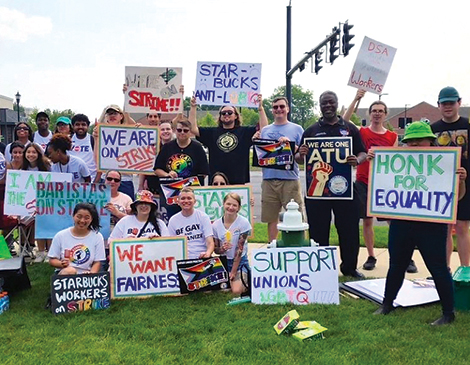
(Photo courtesy Lisa Tan)
Overarching workplace issues may have been a byproduct of the pandemic, bubbling to the surface in the wake of unprecedented volatility in U.S. labor, and, at times, unpredictable profit margins in some of the country’s biggest companies. That storminess hasn’t entirely settled.
It is visible, occasionally overwhelming Starbucks stores: long waits for scheduled drink pickups, crowded lobbies, early close times, frazzled employees.
Beyond the high demand, some Starbucks partners have reported understaffing in the past few years, along with sporadic and unpredictable shifts, low hours and management issues.
Those issues have only swelled, some Northeast Ohio workers say, when they unionize.
Meanwhile, contract bargaining has moved slowly. While SBWU organizers say Starbucks has intentionally delayed the process, Starbucks says SBWU organizers haven’t responded to scheduled bargaining sessions.
In a statement, May Jensen, senior vice president of partner resources at Starbucks, repeated the company’s goal to bargain in good faith: “While we believe the connection and direct relationship we have as partners is core to our culture and craft, Starbucks has approached bargaining with consistency and an earnest desire to progress negotiations for partners at every single store represented by a union.”
Yet, recent labor law decisions tell a different story. Nationally, Starbucks has come under fire for illegally firing some partners and for potential union-busting activities. The NLRB has docketed 665 unfair labor practice charges against Starbucks, including 13 charges in Northeast Ohio that are being investigated or litigated, according to NLRB files.
Local workers’ individual experiences also tell a story: Weber, the Crocker Park Starbucks union wrangler, says his original 20-25 hours per week were at one point slashed to eight hours per week, split between two brief shifts: a perceived form of retaliation when his manager learned he led the store’s union effort. He recounts being written up for small issues that occurred months prior. He says the store’s manager would berate and yell at him and his coworkers in front of customers.
“They want to call us partners, but they don’t want us to be part of this,” Weber says. “I’ve seen Starbucks at their worst: how vindictive they can be about stuff and how they don’t want us to really have a say in it.”
Push and Pull
Weber’s not alone. Other partners at unionized stores have cited similar events. Some noted mandatory sit-downs with higher-ups, used to explain the negatives of a union. Some say their managers have shared inaccuracies about unions, such as stating that union membership could make workers lose benefits or healthcare plans.
Ana Llauder, 26, says she saw a manager at her Crocker Park store manipulate new hires and pit employees against one another and especially against pro-union workers.
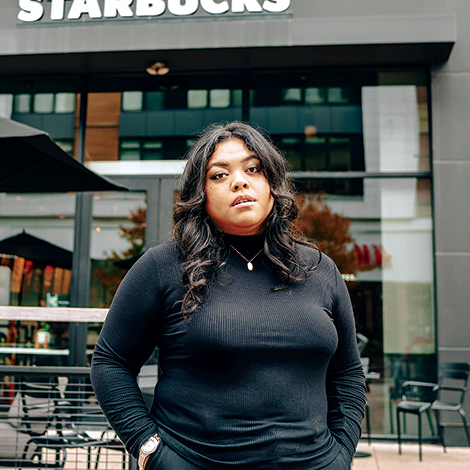
(Photo by Ellen Gobeille)
Lisa Tan, 28, organized the University Circle store’s union. She recounted “brutal” working conditions, where she saw herself and other store employees receive low hours from anti-union managers that prevented them from paying their rent or from reaching baselines required for Starbucks’ healthcare plans to kick in.
Wisam Yaghmour, 21, was hired at a Strongsville Starbucks before the pandemic and saw COVID-19 take a toll on the suddenly understaffed shop. After he led the union effort, he says his manager started writing coworkers up for small issues; he was disciplined for a shift he was late for, despite finding coverage to make up the difference, months prior.
Yaghmour quit Starbucks this past August, he says, as many of his coworkers also departed the store due to bad working conditions and the school year beginning.
“My first year, I was having a pretty good time. Then, eventually, COVID hit, and that just complicated things,” Yaghmour says. “Within the past two, almost three, years, it’s just been progressively getting worse and worse. They started treating us less and less like people after COVID.”
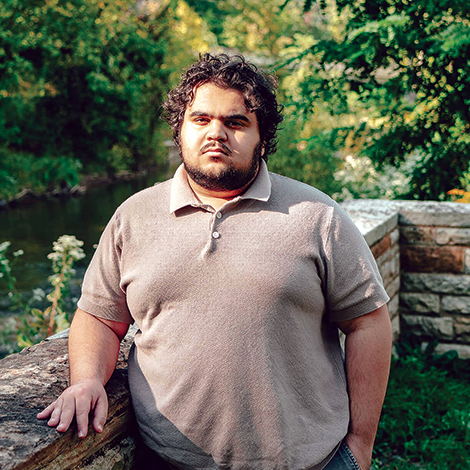
(Photo by Ellen Gobeille)
The dark, early days of the pandemic. When answers to health questions were plagued with at-the-time unknowable futures; when COVID-19 infection rates skyrocketed and hospitals were overwhelmed with patients; when essential employees showed up to care for the sick, to stock grocery stores — and to make coffee.
After cafe closures in March and April, Starbucks baristas, like many service industry workers, showed up for their shifts when the company reopened more than 85% of its stores in May. Some of them wore new, green Starbucks face masks to match their aprons, as they carefully poured tall, grande and venti cups of Pike Place and blonde roast coffee, or as they topped Frappuccinos with perfect dollops of whipped cream. The pandemic’s new demands on work and life strained store workers, while coffee orders only seemed to increase, many of them through Starbucks’ mobile ordering app instead of in-person visits.
In late August, after the World Health Organization reported 4.4 million new cases of COVID-19 in one week, a Buffalo Starbucks was the first in the country to file petitions for a union vote.
More followed suit. Inspired by Buffalo’s unionization, Downtown Cleveland’s West Sixth Street location was the first in the region to pursue a union. It filed for election on Jan. 10, 2022.
Several postponements and delays, and then an election in May. Twelve secret ballots — a simple, standardized form issued by the NLRB — were sent in. Ten checked the box for union representation. Two were challenged. Zero voted against it.
Much in the same way, with different journeys and varying election results, seven more stores in Northeast Ohio pulled enough pro-union workers together to unionize. They were scattered across the region in Cleveland, Westlake, Strongsville, Cleveland Heights, Aurora and Ontario, near Mansfield.
Young employees led many of the efforts. Yaghmour, who turned 21 in September, rallied his Strongsville store.
“I think the younger generation is more motivated to do stuff like this and more motivated to see social change within the places they live,” he says.
Challenging Conditions
Why do these stores want unions? A persistent theme in efforts across the country, according to a SBWU spokesperson, is inadequate scheduling.
Tan saw the issue exacerbated by Starbucks’ online orders clogging up the workday. During shifts at the University Circle cafe, she watched long lines of customers — mainly students and hospital workers — wait for drinks, while a seemingly never-ending roll of online orders flowed in for the small staff.
“Being a coffee shop, people want their drinks, and they’ve gotta go. It was like you were set up to fail,” Tan says. “Serving people food isn’t inherently horrible. You could love doing that; I think a lot of people do. Coffee shops that are maybe better-staffed, or, like, less brutal — it can be a nice place.”
She continued: “I think that’s a hard part of working there, too. For people who worked there before the pandemic, or people who worked there before mobile orders, they knew that it could be a nice place to work and it just wasn’t.”
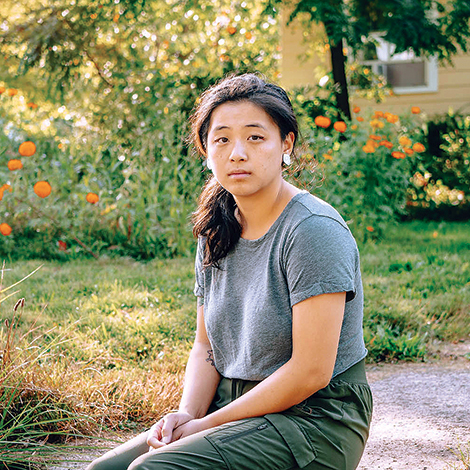
(Photo by Ellen Gobeille)
It can quickly lead to overwhelming situations, partners say. At the Crocker Park Starbucks, what used to be a regular shift would lead to workers being stretched thin, Llauder says. “When you’re working a five- or six-hour shift, it shouldn’t feel like 10 because you did five jobs, just because they want to keep the labor hours down,” she says.
The workers interviewed for this story noted supervisors who were anti-union, who manipulated scheduling, driving some pro-union employees out with poor hours. Though Starbucks policies prohibit retaliation against unions, some workers say they still see it happen in myriad ways.
Tan says she started working at Starbucks with an aim to unionize the store, but she was also drawn to how the company’s perks supported her work as an adjunct professor at the Cleveland Institute of Art, teaching animation. She especially liked Starbucks’ option for part-time health insurance: a
rarity in the service industry.
Just shy of her one-year anniversary, Tan received a pin to commemorate 365 days of employment at the shop.
Then, she quit. She’d had enough, she says, of watching friends fired or forced out of the shop. Enough of the overwhelming demands in what was supposed to be a low-key, part-time gig. Enough of the problems she was trying to solve with a union, but that never seemed to budge.
In a list on its website, SBWU compiles many core union demands, based on surveys with Starbucks partners across the U.S. The list includes implementing just cause for firings and discipline, seniority rights for employees, faster accrual of PTO, better sick time and, perhaps most strikingly, a bump to $20 base pay, with $25.40 for shift supervisors.
“I didn’t think I was going to quit after a year. I was all bright-eyed, bushy-tailed, ready to go. I was like, ‘This could be it,’ because I’d been looking for years for a place where I could stay,” Tan says. “If you go to college and you don’t get that job that lasts for 50 years like our parents did, or whatever — instead you find yourself having to move all the time. When I started at Starbucks, they were already working on getting a union. If we won a union, we could make this a place that people can stay.”
The University Circle Starbucks location unionized last summer, but it was a slim win for pro-union workers, with a vote of 11-9. Afterward, Tan had mixed feelings.
“It makes you feel some type of way after you win an election by that small, little margin. ‘Is half of my store against us having better working conditions?’” Tan says. “It felt bad. But we won, so that was good.”
Now, the tide may turn: the University Circle shop is the only unionized Starbucks in Northeast Ohio with an active decertification petition open — meaning that current workers filed to de-unionize. The case was filed with the NLRB on Aug. 17.
Despite all of that, Tan says she supports other Starbucks’ unions, as a member of the Cleveland chapter of Democratic Socialists of America, which aided some local shops in their union journeys. When she hears about a strike, she regularly shows up on the picket line, joining people like Weber, who continue to push the effort forward.
The Fight
Weber meets for this story’s interview in Kamm’s Corners, at P.J. McIntyre’s Pub just as it opens for business on a weekday. It takes a while for the lunchtime crowd to trickle in. He orders a cup of black coffee, served steaming in a glass mug.
“I drink a lot of coffee. I’m usually, like, a three-pot-a-day type of person,” the 34-year-old says, with a laugh. “I legitimately am a coffee nerd. I have an espresso machine at home that has the latte maker; I have the French press, the cold brew iced coffee maker, all of them.”
But, here, talking about coffee — that’s what this is all about, isn’t it? Coffee? — one truth sneaks out, one that projects from the conversation about his work, a little quirk that maybe says something big about Starbucks in the end.
“I’ll admit it,” he says. “I don’t like their coffee. But I did like the atmosphere.”
After working in coffee shops through college, Weber chose to work for the chain to supplement his full-time job as a Positive Education Program teacher for children with developmental challenges.
The work is hard, Weber says; the days are long. He wanted a second job; something chill, where he could take his mind off of things — and with all of its benefits, why not Starbucks?
It doesn’t seem to matter much if Weber likes the coffee. At the best of times, it’s a fun place to work, he says. He likes a lot of his coworkers. It’s a nice distraction from his day job. It’s a good source of extra money. The perks are great.
His first day was in November 2021. Not long after, his wife told him about the Buffalo union. It was a no-brainer to support a similar move in his own store, Weber says. He’d been involved in the process before, in a former job’s relatively smooth bargain with Service Employees International Union.
“I’m one of those people who feel that every place needs a union no matter how great it is, because at some point, it will fall,” Weber says. “It’s great to have a union and not need it; it’s better than to need one, and not have one.”
Later, after he’s shared stories of Starbucks strikes, these proud notches on his belt, he admits something else.
“It’s not something we want to do. We are all very eager to come and sit at the table and write, and talk,” Weber says. “We like our jobs; otherwise, we wouldn’t be fighting for them. We like where we work; otherwise, we wouldn’t be fighting for it. But we just need them to come and bargain in good faith.”
Take another sip of Cleveland's coffee scene:
- Ready Set Coffee Roasters’ Chris Allen Is a Hardcore Garage Roaster
- Locally Found Coffee Products Every Clevelander Needs
- Cafe Conversations with Cleveland Coffee Shop Baristas
- Honduras to Cleveland: The Story Behind Roasted's Coffee Beans
Start your day the best way by signing up for our free daily newsletter. Arriving in your inbox every morning to keep you in the loop on the best guides, home and style tips, and news briefs for all things Cleveland. Click here to subscribe.

